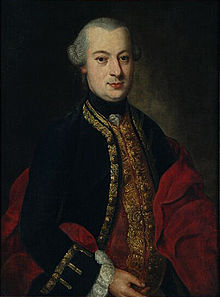Wittgenstein Palace (Düsseldorf)
The Palais Wittgenstein cultural center at Bilker Strasse 7-9 in Düsseldorf's Carlstadt district houses a chamber music hall, the Düsseldorf Marionette Theater , the Institut Français Düsseldorf and an Art Nouveau cafeteria (former London butcher shop, formerly Lorettostrasse ).
history
The building known today as Palais Wittgenstein (house no. 7) was built after 1790 by the wine merchant Heinrich Huyssen, who came from a family in Essen, when Carlstadt was settled. In 1801 he lived again in Essen, but he still owned the house. The next owner was the Senate President Johann Theodor Jakob Reichsfreiherr von Kylmann (1751–1837), later his daughter Constanze (1801–1872) and her husband Freiherr Phillip von Lezaack (1796–1878). In 1874 Prince Alexander zu Sayn-Wittgenstein bought the house, but he left it again in 1876. In 1878 the wine merchant Eduard Hauth moved his wine shop from Schwanenmarkt to Bilker Straße 7 and was able to use the wine cellar that Huyssen had set up. In 1887, among other things, he had the courtyard built. The gate of Palais Wittgenstein is the masterpiece of Paul Bogus, bought on the occasion of the trade exhibition in Düsseldorf in 1902 for the Hauth house, Bilker Strasse 7, for 600 gold marks . House number 9 was built by Gottfried Bensberg, owner of the cabbage mill in Neustadt. In 1790 the engraver Johann Gerhard Huck lived here .
The building complex at Bilker Strasse 7-9 was transferred to the state capital Düsseldorf. 1974-76 the buildings, which were badly damaged in the Second World War, were historically reconstructed in the exterior by the municipal building department, architect Alo Terhoeven, and the interior was furnished according to modern requirements. In 1976 the Wittgenstein Palace was opened as a cultural center. As part of the renovation work, the former Peter London butcher's shop, previously 30 Lorettostraße, acquired by the city of Düsseldorf in 1975, was built into the palace and has been used as a cafeteria ever since. It is an example of historicism around 1900 and was acquired by Theodor London on the occasion of the world exhibition in Ghent, Belgium for 28,000 gold marks, exhibited there in 1906 and awarded a first prize.
Todays use
The Institut Français Düsseldorf, founded in 1950, moved to Palais Wittgenstein in 1977. It organizes language courses and cultural programs and maintains a media library, offices and course rooms.
Regular concerts and readings take place in the chamber music hall of Palais Wittgenstein, which has 234 seats.
Via the inner courtyard of the Palais one arrives at the Düsseldorf Marionette Theater , which shows sophisticated productions for adults and older children from eight years in around 230 performances per year. The repertoire includes 22 productions, including operas and modern music theater, dramas and fairy tales, with a focus on adaptations of Michael Ende's works. The theater has workshops and a theater fund in the basement with over 500 characters. The Marionetten-Theater has been located in the Palais since 1965, until 1985 as "Theater Rheinischer Marionetten" of the Zangerle family, since 1986 as "Düsseldorfer Marionetten-Theater gGmbH" under the direction of Anton Bachleitner.
literature
- State capital Düsseldorf, Der Oberstadtdirektor, Kulturamt (Ed.), Klaus Lehmann (Editor): Düsseldorf, Kultur- und Bildungszentrum Bilker Str. 7–9 [Palais Wittgenstein]. Düsseldorf 1986.
- Anton Bachleitner: The Düsseldorf Marionettes, Puppets & Masks. Frankfurt 2003, ISBN 978-3-935011-39-6 .
Web links
- Cultural Office Düsseldorf, Palais Wittgenstein
- Homepage of the Institut francais Düsseldorf
- Homepage of the Düsseldorf Marionette Theater
- Entry in the monument list of the state capital Düsseldorf at the Institute for Monument Protection and Preservation
Coordinates: 51 ° 13 ′ 20.7 ″ N , 6 ° 46 ′ 21.5 ″ E

